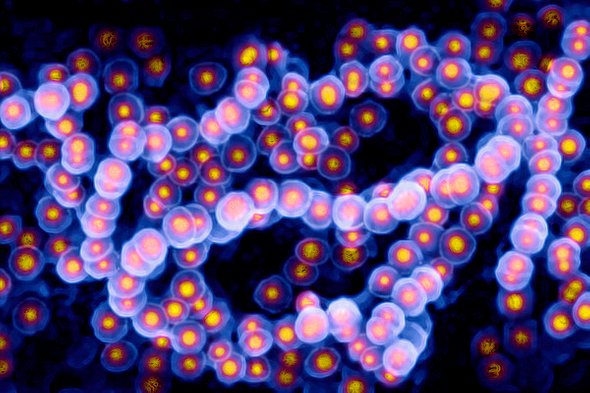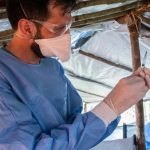
In my line of work as CEO of a bioremediation technology company that uses microbes for wastewater treatment, I’m keenly aware of the value microbiology brings to society.
However, it wasn’t until January of this year that I quite literally felt the full might of microbes: with little warning, I found myself locked in a battle with powerful Pseudomonas spp. bacteria, which defeated my immune system’s first line of defense. This weakened state allowed flesh-eating Streptococcus A bacteria, which most of us commonly encounter with little effect, to attack me—a lethal one-two punch. I narrowly escaped with my life.
The bacteria infected my left arm, and progressed so quickly that the doctors were forced to complete a left shoulder disarticulation, which completely removes the arm from the humeral head, to prevent the bacteria from taking hold in my chest and attacking my vital organs. It took the microbes less than three days to progress from the initial assault to threatening my life, all while I was under some of the best medical care and supervision in the world.
Obviously, the experience has permanently altered me, but it also left an indelible impression as an example—an extreme one, to be sure—of the power these tiny creatures have over how we live. Most importantly, it reinforced my belief that harnessing microbial power can do almost unimaginable good for our civilization.
Microbes are in the air we breathe; they cover every inch of our skin and the ground we walk on. In fact, an estimated one trillion species of microbes live on our planet, and 99.999 percent of them have yet to be discovered. Humans have always coexisted with microscopic life, but it’s only now that we’re realizing their potential to help solve our most pressing problems—and we’ve barely scratched the surface. With its intricate embedded functions, microbiology is nature’s operating system. Investigations into and developments in microbiology decipher this operating system and create “hacks” that can help us.
We often follow the precautionary principle to our detriment when it comes to nature’s mysteries, equating the unknown with danger. Over the past century, we’ve turned microorganisms in all their forms (bacteria, fungi, viruses) into enemies that must be sterilized and cleansed from our lives.
Instead, let’s reframe the unknown qualities of microorganisms to focus on their potential instead of their dangers. Scientists are now exploring the niche processes and surprising functions that come from microbial interactions. Through 21st-century technologies such as low-cost DNA sequencing, we’ve begun to understand the secret world of microbes and their potential to serve us.
Tapping into the power of microbes has established new roles for these tiny life forms in mediating humans’ conflicted relationship with our environment. For example, researchers are discovering microbial solutions in agriculture that outperform man-made alternatives. Though certain microorganisms that live on crops can spread disease to humans, another type of microbes can be enlisted to fight off harmful pathogens.
In one case, researchers in Virginia spread anti-Salmonella soil bacteria on tomato seedlings in an effort to prevent outbreaks of food poisoning. In another, scientists in Colombia, learned that microbes introduced to plant roots could be a new source of phosphate to replace chemical fertilizers. Essentially, microbes can help us safely provide for ourselves.
Microbes can also help shrink our waste. Humans have managed to generate more than 9 billion tons of plastics since 1950, creating a plastic garbage patch floating in the Pacific Ocean that is nearly twice the size of my onetime home of Texas. Plastic left to its own devices takes more than 400 years to degrade, but newly-discovered bacteria can break down the polyethylene terephthalate, or PET, that makes up disposable water bottles, frozen-dinner trays and even polyester clothing.
Bioremediation techniques have been employing specialized bacteria for decades to degrade targeted pollutants, including oil and other petroleum products and solvents and pesticides found in soil or groundwater. New tools can boost nature’s processing power by creating a more favorable environment that enhances the activity of microbes already living at the contaminated sites.
Today we have more powerful technologies than previous generations could have imagined. Thanks to advances in the medical field, I not only survived my intense fight with flesh-eating bacteria, but I expect to regain many of my physical abilities over time thanks to continued advances in robotics and materials science for artificial limbs. Although today’s commercially available prosthetics have just scratched the surface of what’s possible, they will one day be receiving brain signals that previously controlled my biological arm to operate a “bionic arm.”
Research and investment make such astounding innovations possible. With more resources, we can apply 21st-century technology to unlocking the power of microorganisms for good and expanding explorations into their unique abilities to tackle humankind’s biggest challenges. Given the speed and potency of microbial interactions, which I know from personal experience, their problem-solving potential is almost incomprehensibly large.
Let’s go down the microbial rabbit hole and take on the future with nature.











RSS